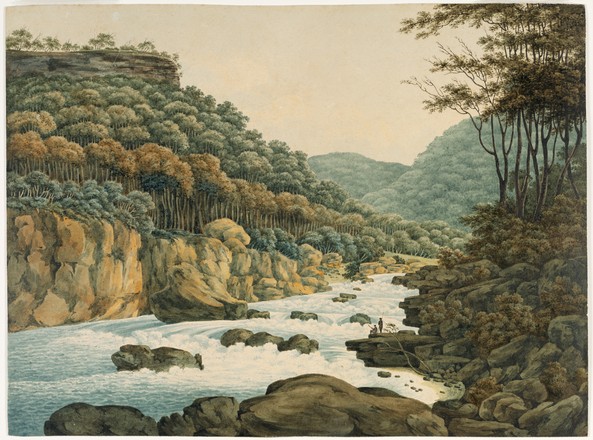A view near Grose Head, NSW
1809
SV / 143
Watercolour
In 1813 the respected surveyor and explorer George William Evans (1780–1852), was sent by Governor Lachlan Macquarie to find a passage through the interior of New South Wales. He followed the route of the Blaxland, Wentworth and Lawson expedition, and became the first European to cross the Great Dividing Range into the expansive lands of New South Wales where he founded the site for Bathurst.
As well as being a competent surveyor, Evans was also an accomplished artist. His View near Grose Head, New South Wales (1809), with its wild landscape and untouched beauty, is thought to be one of the earliest surviving depictions of a Blue Mountains view. The work probably depicts the Grose River near the base of Grose Head, at the foothills of the Blue Mountains.
Impenetrable interior
The Blue Mountains generally remained an impenetrable mystery to colonists until the official crossing in 1813. In 1805, Governor Philip King had described the Blue Mountains as “a confused and barren assemblage of mountains with impassable chasms between.” *
William Paterson (1755-1810) described his 1793 expedition of the Grose River valley to Francis Peron (1775-1810) as “In vain did the travellers attempt to continue their route towards the interior of the mountains: their difficulties increased at every step; one of these mountains was not less than four hundred feet in perpendicular height; frightful precipices everywhere presented themselves; and no sooner had one summit been escalated, then another appeared still more barren and difficult of access…”**
Footnotes
* Historical Records of Australia, edited by Fredrick Watson, 1914-1925, Vol.5, p.594
** Francois Peron, A voyage of discovery to the Southern Hemisphere, London, 1809. p.288
George William Evans
As a man
from a middle class background, the English-born George William Evans received
numerous privileges when he and his family settled in Sydney in 1802. Upon his
arrival, he was granted 519 acres of prime farming land at Richmond, and the
following year, he was appointed to the role of acting surveyor-general.
Evans
quickly earned a reputation for being a talented explorer and surveyor. In
1804, he discovered and explored the Warragamba River, penetrating upstream to
the present site of Warragamba Dam.
Evans’ led
many successful surveying journeys during his career. In 1812, he conducted a
difficult surveying expedition down to the previously unexplored Jervis Bay,
before heading inland to Appin. His discoveries on this journey lead to the
settlement of the Illawarra district,* which offered rich farming land. Evans’
accomplishments in the south of the colony were praised by Governor Lachlan
Macquarie, and were probably the reason why the Governor selected him for his
most important task of penetrating the interior of New South Wales. *
Footnotes
* Australian Dictionary of Biography
online http://adb.anu.edu.au/biography/evans-george-william-2029



 Back to list
Back to list